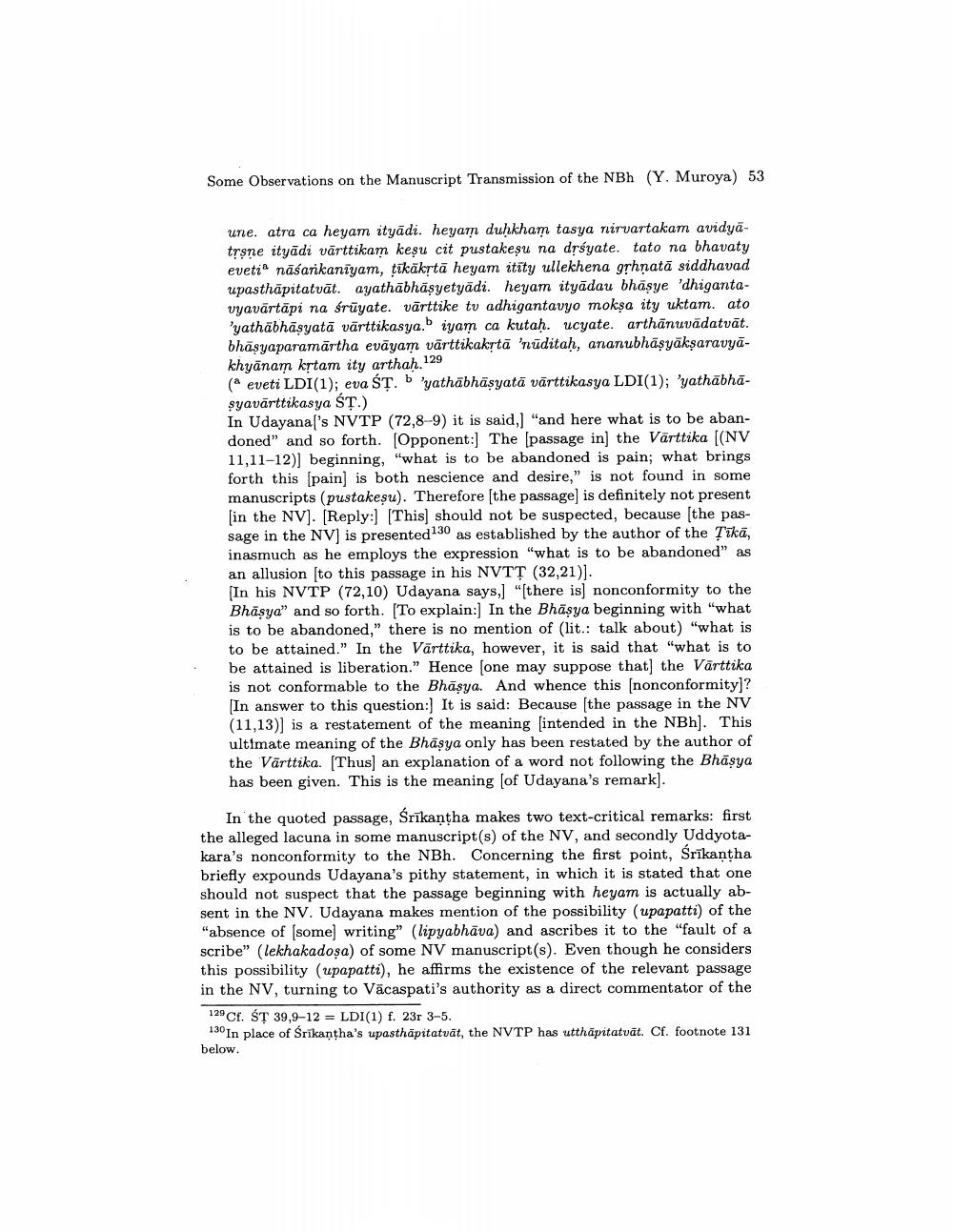________________
Some Observations on the Manuscript Transmission of the NBh (Y. Muroya) 53
une. atra ca heyam ityādi. heyam duhkham tasya nirvartakam avidyatrsne ityādi vārttikam keşu cit pustakeșu na drśyate. tato na bhavaty eveti nāśarikaniyam, tikäkrtā heyam itīty ullekhena grhnatā siddhavad upasthāpitatvāt. ayathābhāşyetyādi. heyam ityādau bhāsye 'dhigantavyavärtäpi na srüyate. värttike tv adhigantavyo moksa ity uktam. ato 'yathābhāsyatā vārttikasya. iyam ca kutah. ucyate. arthānuvädatvāt. bhāsyaparamartha evāyam vārttikakrtā 'nūditah, ananubhāsyākşaravyākhyānam krtam ity arthah.129 ( eveti LDI(1); eva ŚT. b 'yathābhāsyatā vārttikasya LDI(1); 'yathābhāsyavärttikasya ST.) In Udayanal's NVTP (72,8-9) it is said, "and here what is to be abandoned" and so forth. (Opponent: The passage in the Värttika ((NV 11,11-12)] beginning, "what is to be abandoned is pain; what brings forth this pain) is both nescience and desire," is not found in some manuscripts (pustakesu). Therefore (the passage) is definitely not present [in the NV). (Reply:) (This) should not be suspected, because (the passage in the NV) is presented130 as established by the author of the Țikā, inasmuch as he employs the expression "what is to be abandoned" as an allusion to this passage in his NVTT (32,21)]. (In his NVTP (72,10) Udayana says, "there is nonconformity to the Bhāsya" and so forth. (To explain: In the Bhäsya beginning with "what is to be abandoned," there is no mention of (lit.: talk about) "what is to be attained." In the Vārttika, however, it is said that "what is to be attained is liberation." Hence (one may suppose that the Vārttika is not conformable to the Bhāsya. And whence this (nonconformity)? [In answer to this question:) It is said: Because (the passage in the NV (11,13)) is a restatement of the meaning intended in the NBh). This ultimate meaning of the Bhāşya only has been restated by the author of the Värttika. (Thus) an explanation of a word not following the Bhāsya has been given. This is the meaning (of Udayana's remark).
In the quoted passage, Srīkantha makes two text-critical remarks: first the alleged lacuna in some manuscript(s) of the NV, and secondly Uddyotakara's nonconformity to the NBh. Concerning the first point, Srikantha briefly expounds Udayana's pithy statement, in which it is stated that one should not suspect that the passage beginning with heyam is actually absent in the NV. Udayana makes mention of the possibility (upapatti) of the "absence of some writing" (lipyabhāva) and ascribes it to the "fault of a scribe" (lekhakadosa) of some NV manuscript(s). Even though he considers this possibility (upapatti), he affirms the existence of the relevant passage in the NV, turning to Vācaspati's authority as a direct commentator of the 129 Cf. ŚT 39,9-12 = LDI(1) f. 23r 3-5. 130 In place of Srikantha's upasthäpitatvāt, the NVTP has utthäpitatvāt. Cf. footnote 131 below.




